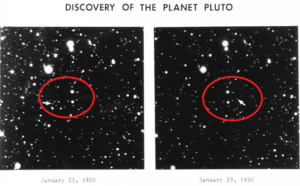Is Pluto a planet? Or why Pluto is no longer a planet? Or why is Pluto called a dwarf planet? These few questions are puzzling to many. In this article, you all will get your answers.
For about 76 years, students have read that “there are nine planets in our solar system.” And The smallest of these nine planets is Pluto.
However, in 2006 Pluto was removed from the list of planets. Why is Pluto suddenly removed from the list of planets, despite the fact that its shape hasn’t changed?
In 2006, the International Astronomical Union, an organization of astronomers, redefined the word “planet”. In their new definition, Pluto was left out of the list of planets. They announced that Pluto is a dwarf planet.
Before we get into why Pluto lost its status as a planet, let’s have a look at some facts about Pluto.
Pluto
How Pluto was discovered
Mercury, Venus, Earth, and Mars are the first four planets in our solar system, and they are all rocky planets. Jupiter, Saturn, Uranus, and Neptune are the gas giants.
The planet Neptune was first found in the 1840s by looking at the orbits of Uranus. Following this event, astronomers speculated that the Planet Nine could be discovered by observing Neptune’s trajectory.
Percival Lowell, a wealthy American businessman, author, mathematician and astronomer, established the Lowell Observatory in Arizona, USA, in 1894 to observe the sky. The search for the ninth planet began in 1906, and in 1909, some possible locations of the ninth planet were announced. However, it was not very fruitful later.
The Lowell Observatory was closed for a long time after Percival Lowell died in 1918. Although Lowell could not find much information about the Ninth Planet, Pluto was vaguely depicted in two of his photographs taken in 1915. But it was so small and dull that no one cared.
After a long hiatus, the quest for the mysterious Planet Nine resumed at the Loyal Observatory in 1929. American astronomer Clyde Tombaugh was hired for this job.
Taking photographs with a telescope and combining the taken images one after the other to determine a moving object- based on these two principles, Clyde Tombaugh discovered a moving object in space on February 18, 1930. He forwarded his findings to the Harvard College Observatory after further research. After double-checking everything, the people of the world were introduced to the solar system’s ninth planet, Pluto.

Here’s some information on Pluto:
Pluto can never be identified with the naked eye because Pluto is not one of the brightest objects in the sky. Pluto’s distance from the sun is 2.6 billion miles when it comes closest to the sun and 4.5 billion miles from the sun when it moves farthest from the sun.
Pluto has a diameter of only 1,375 miles, which is about one-fifth of the Earth. Pluto takes 246 years to orbit the sun once. Pluto’s average temperature is minus 212 to 226 degrees celsius due to its distance from the sun.
Pluto also has a moon. Pluto’s moon is only 12,000 miles away from it, and that the moon’s diameter is half that of Pluto. Except for Pluto, no other planet in the solar system has a lunar diameter half of that. Pluto’s moon is named Charon.
Why is Pluto not a planet? Why is Pluto a dwarf planet?
There have been many arguments against whether Pluto should be considered a planet. An object in the solar system must meet three conditions recognized by the International Astronomical Union to be classified as a full-sized planet:
1. It will revolve around the sun. For example, the moon is not a planet as the moon revolves around the Earth.
2. It must have enough mass.
3. It must have a smooth neighbourhood.
Pluto failed to meet the third of these three conditions. Pluto revolves around the sun, its shape is round but Pluto’s orbit is not distinct. When Pluto rotates in its circle, it enters Neptune’s orbit. Pluto was also unable to exert any influence in its orbit due to its diminutive size.

When all the other planets in the solar system revolve around the sun, it clears all the debris around its orbit with the gravity created by its own mass. But Pluto can’t do that. Pluto’s orbit is littered with large and small debris. As a result, Pluto’s status as a full-fledged planet was revoked, and it was demoted to a dwarf planet. In our solar system, there are 44 dwarf planets.
There is another reason why Pluto is not a planet. At different times since 1992, more objects have been discovered at Pluto’s distance from the Sun. Which are around the same size as Pluto. Another dwarf planet, 28 percent larger than Pluto, was discovered near Pluto in 2005. It is named “Eris”.
Astronomers detected another big object called ‘2003 UB313’ further beyond Pluto, towards the far end of the solar system. Why aren’t these objects larger than Pluto acknowledged as planets if Pluto is? However, none of them achieved full planet status because they failed to meet three of the International Astronomical Union’s criteria.
Hopefully our dear readers have found the answer to why Pluto is called a dwarf planet or why Pluto is not a planet.
